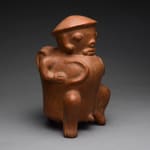Terracotta Sculpture of a Hunchback, 300 BC to 300 AD
Terracotta
PF.4628-1
Further images
In Mesoamerican culture it was customary for deformed individuals to dedicate their lives to shamanism. These special individuals were respected and held in high regard. In other words, they were...
In Mesoamerican culture it was customary for deformed individuals to dedicate their lives to shamanism. These special individuals were respected and held in high regard. In other words, they were considered prophets and would lead the course of the tribe. They would take hallucinogens and the result of their hallucination would decide what the tribes’ next move would be.
This special effigy vessel of a seated man is extraordinarily crafted. He has a pigeon chest that is enhanced by wonderful tribal etchings and patterns. The shoulders are round and the arms loop to the sides with the hands placed on the chest. The rendering of the face is limited in design; his eyes are placed wide apart and the nose and mouth rest lightly upon his pigeon chest. The head is donned with a mushroom shaped hat that has pattern work across the top. The earlobes are pierced as well.
Perhaps the most beautifully rendered part of this piece is the exaggerated depiction of the hunchback that is very large in comparison to the rest of the body. It too has tribal etchings and symbolic designs along the top and the sides. The bottom of the hump slopes into the body that elegantly displays the artistry involved in making such a work of art. The bottom of the figure is also lined with patterned markings. In this ancient culture, beauty is in its deformity. It is something special that the culture revered, giving these individuals significant status in their tribe. Collectively, this piece as a work of art and a respected figure gives insight into the mysterious culture of the Costa Ricans.
This special effigy vessel of a seated man is extraordinarily crafted. He has a pigeon chest that is enhanced by wonderful tribal etchings and patterns. The shoulders are round and the arms loop to the sides with the hands placed on the chest. The rendering of the face is limited in design; his eyes are placed wide apart and the nose and mouth rest lightly upon his pigeon chest. The head is donned with a mushroom shaped hat that has pattern work across the top. The earlobes are pierced as well.
Perhaps the most beautifully rendered part of this piece is the exaggerated depiction of the hunchback that is very large in comparison to the rest of the body. It too has tribal etchings and symbolic designs along the top and the sides. The bottom of the hump slopes into the body that elegantly displays the artistry involved in making such a work of art. The bottom of the figure is also lined with patterned markings. In this ancient culture, beauty is in its deformity. It is something special that the culture revered, giving these individuals significant status in their tribe. Collectively, this piece as a work of art and a respected figure gives insight into the mysterious culture of the Costa Ricans.







